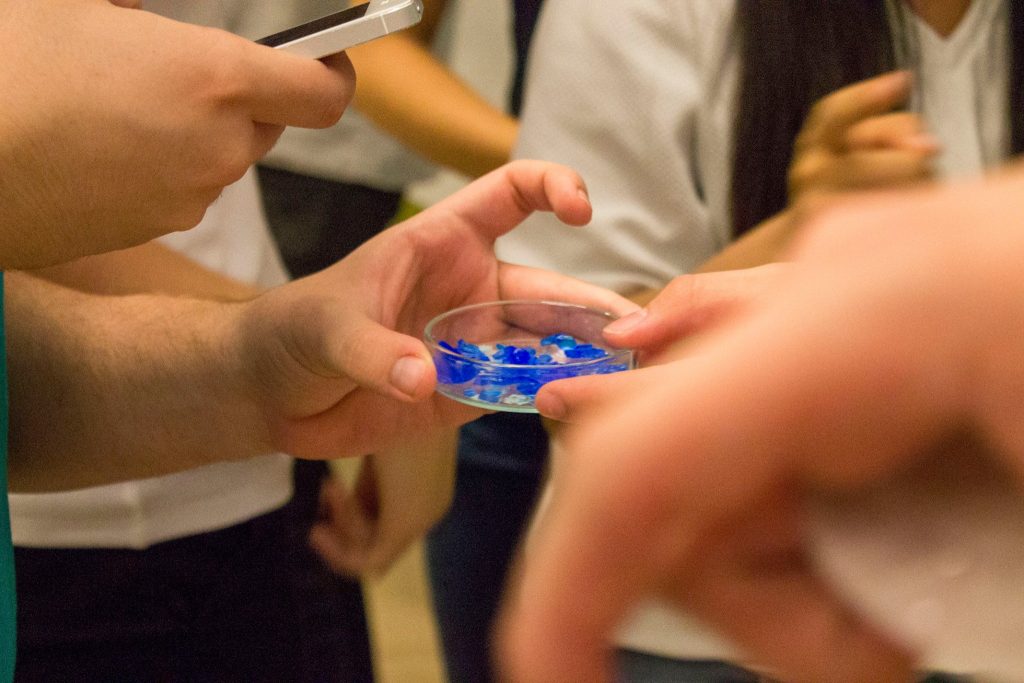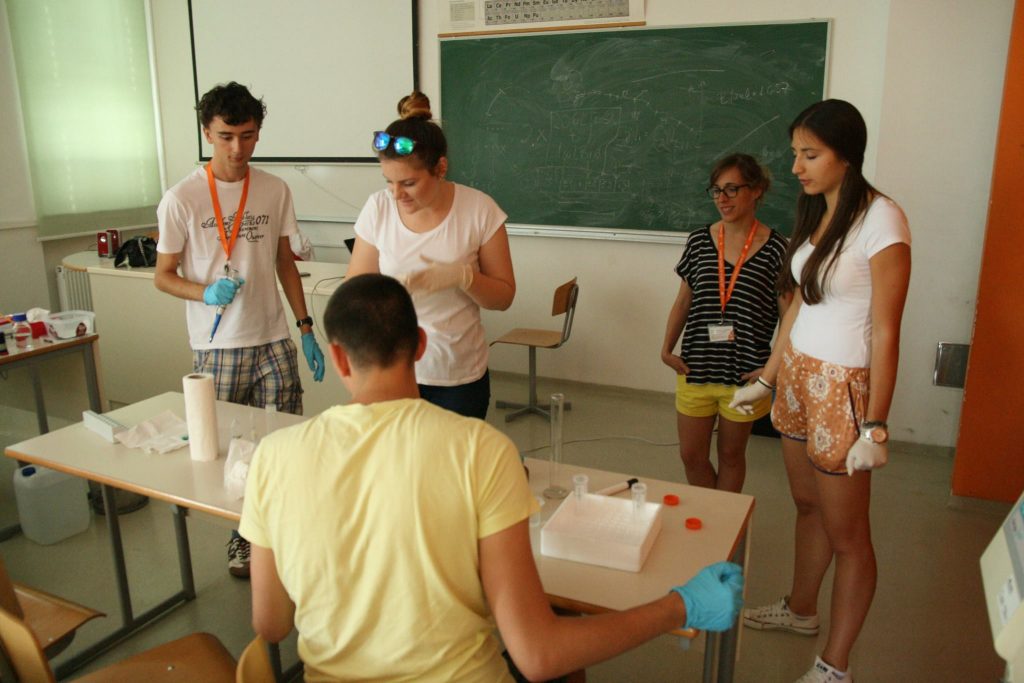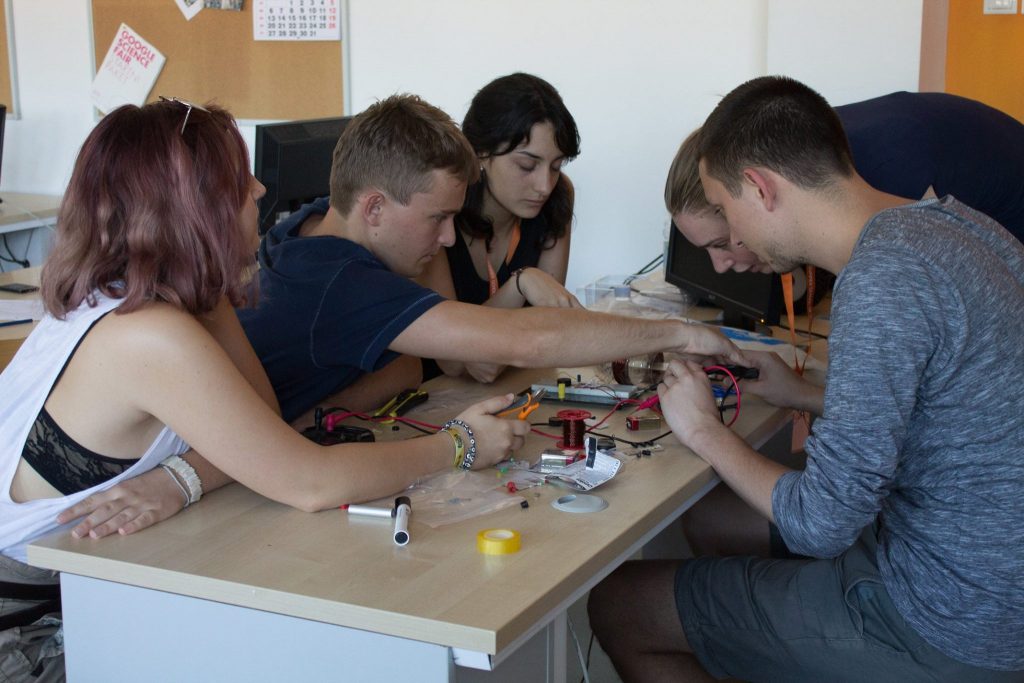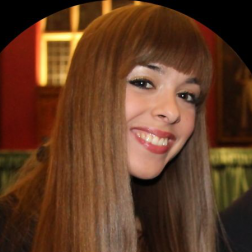EMBL School Ambassador Matilda Males
Country: Croatia
Profile
My name is Matilda and I am a PhD student at the EMBL Heidelberg. Within the course of my PhD project, I am trying to understand how the non-coding genome can contribute to the regulation of gene expression during embryonic development.
Before I joined the EMBL, I studied Molecular and Cellular Biology in Zagreb, Croatia and Heidelberg, Germany.
My passion for science was sparked way back in high school by PhD students who were doing exactly what I’m trying to do today – promote science among pupils and try to show people that scientist are not some weirdoes with big glasses and uncombed hair, but actually quite the opposite. Nowadays I am trying to do the same – test my creativity and take the challenge to teach and communicate science to a non-scientific audience. During my studies I took part in various science outreach activities such as volunteering at science festivals, teaching at the Summer School of Science and tutoring practicals for undergrad students. I believe that only by communicating science we make people realize what an impact science has on our daily lives. Also, it can help us as scientists to better comprehend our own work and look at it from some new angles, because just like Einstein once said: “You do not really understand something unless you can explain it to your grandmother.”
July 2014, mentor at Society Out-of-Frame Education S3 Summer School of Science, Pozega, Croatia:
» Summary of project offered at Summer School of Science (Diary 1)
» Reflections on the Summer School of Science from the perspective of mentor (Diary 2)
July 2014, mentor at Society Out-of-Frame Education S3 Summer School of Science, Pozega, Croatia:
» Reflections on the Summer School of Science from the perspective of organiser (Diary 3)
Diary 1
Evolution in the era of genomics: Exploring the genome architecture with NGS
Summary of the project which was offered by Jelena Tica and Matilda Males at the Society Out-of-Frame Education S3 Summer School of Science in July 2014.
One of the breakthroughs in molecular biology was discovery of the genetic code in 1960s. Today, we are very well aware of the fact that DNA of every organism hides important information dictating not only its future, but also revealing its ancient evolutionary past. Although the method to determine the base sequence of nucleic acids was already developed in the 1970s, not until recently it was a daunting and challenging task to obtain a DNA sequence from an organism. However, nowadays we are facing a rapid development of the new generation sequencing systems followed by a multitude of novel applications in biology and medicine. For example, today it is possible to sequence several human genomes in a single run in a matter of days. The ability to sequence the whole genome of many related organisms has allowed large-scale comparative and evolutionary studies to be performed that were unimaginable just a few years ago. In terms of evolution, the next generation sequencing (NGS) enabled us to investigate depth of information beyond the capacity of traditional DNA sequencing technologies and therefore show that variations in the genomic structure, such as variation in copy numbers and inversions of DNA sequence, are a major source of human evolution and phenotypic variation. As a part of this project, participants will be given DNA-Seq and RNA-Seq data originating from different primate species. Their task will be to use given sequencing information to find structural variations such as deletions, duplications and translocations in the respective primate genomes and correlate these variations with the effect on gene expression. Potential candidate regions predicted to be affected by a structural variation would be subsequently experimentally confirmed by using PCR and gel electrophoresis. Few of the main challenges participants will face in this project will be application of various bioinformatics tools to assess and analyze NGS data, followed by experimental validation of predicted results, and finally understanding how genome architecture may lead to phenotypic variation.
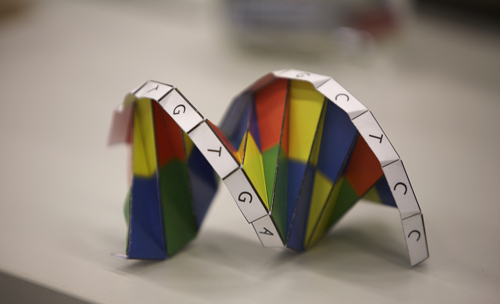
Diary 2
Reflections on the Summer School of Science, July 2014 – from the mentors’ perspective
“The Summer School of Science was truly a memorable experience, where I learned so much and gained so many skills that will for sure be of very valuable use in the future.” – Ana, Germany
Summer School of Science is a 10-day long international summer workshop for high school students. It was established in 2001 with the intention to bring together bright young people with strong interest in science and show them how working in a scientific environment looks like. The school runs once per year, and the place of happening for the last two years has been Pozega, a small picturesque town in the north of Croatia.


We were invited to participate as project leaders; that said we needed to think of a compact scientific project and lead a group of 5 students through it during the short period of 10 days. Our initial motivation to accept the challenge was the opportunity to work with students, teach and try to change things we didn’t like during our own school days. But we have to admit that we haven’t really expected how much the students will actually appreciate attending the Summer School.
“Young scientists, our mentors and organizers, taught us how beautiful and interesting science can be.” – Martina, Croatia
We started working on the project half a year before the actual start of the Summer School. It took a lot of time to design the experiments and prepare all the needed protocols and files, as our project was part computational and part experimental. Our group was looking into three different primate genomes and exploring structural variations (SVs) similarities and differences within and between species. The aim of our experiments was to investigate different genomes in order to understand how variations in the genome architecture may lead to phenotypic differences.
Once at the School, we usually met up with the students at 9am and worked with them until 6pm. In the evening, we had a guest talk, before socialising with participants and lecturers. During the school, students also had to give presentations to explain their project and results to the others and at a very end they prepared a lab report in a form of a small scientific article.
“There are only a few words that could describe my happiness because I was given the opportunity to be a part of this School and to be in such a great team!” – Tin, Croatia
Ana, Jovan, Martina, Sara and Tin were the students forming our team – the SEQuers, who seek the knowledge by sequencing. For us, the most rewarding experience was seeing their progress each and every day, seeing how much they appreciate our efforts and receiving their more than positive feedback. Of course, there were also some challenges such as adapting the level of the program to five different students with different backgrounds and trying to transfer our knowledge in a way that it is understandable to everyone. Nevertheless, not even at a single point we felt discouraged or that this event was not worth all the time and effort we invested in it.


“Working on the project as a whole was really fun and we got to meet a lot of interesting people, who come from very different backgrounds and cultures.” – Sara, Serbia
One additional benefit of attending the school was definitely meeting science enthusiasts from all around the world, from Nobel prize winner Tim Hunt to students from Spain, Poland, Bosnia, Slovenia, Portugal, Croatia, Slovakia, France, Serbia and Turkey. During those 10 days we gained friends and colleagues we hope to stay in touch and potentially even collaborate with. We would definitely do it again, and in fact we both hope to be involved in the Summer School already next year.
“I met some incredible people who became unforgettable part of my life. Experiences and amount of knowledge I have gained are enormous.” – Jovan, Serbia

Diary 3
Reflections on the Summer School of Science 2015 from the organisers’ perspective
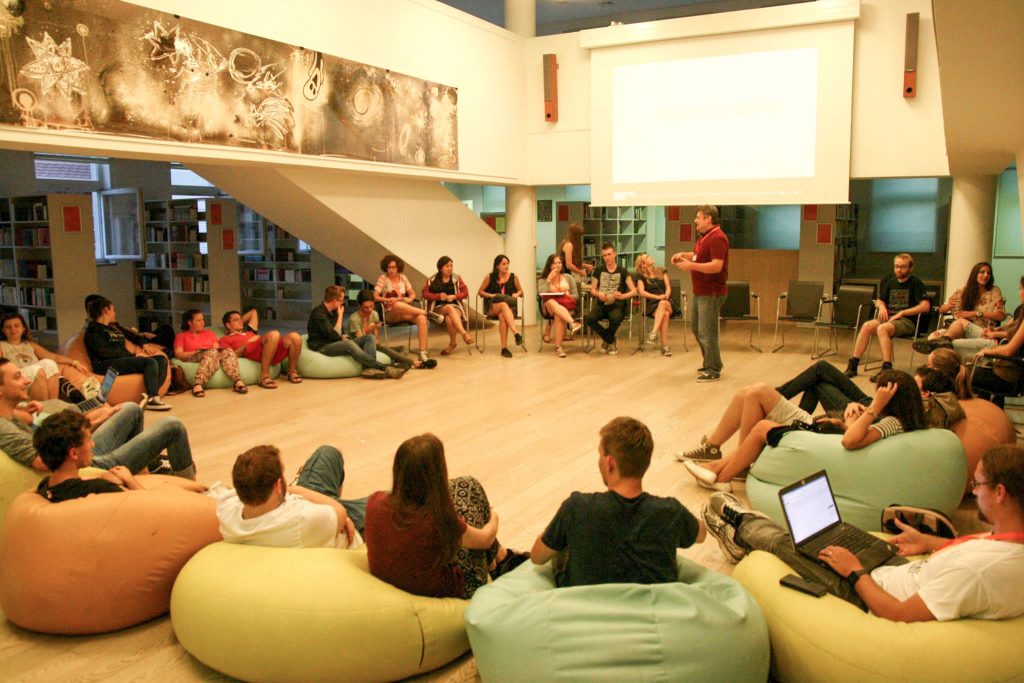
Summer School of Science (S3) is a 10-day long international summer workshop for high school students, established in 2001. It aims to bring together young people with a strong interest in science and give them an opportunity to gain hands-on experimental experience, as well as a chance to create a network of peers with similar interests.
You already got the chance to read about our involvement in Summer School of Science as teachers/project leaders in 2014.
We both very much enjoyed our 2014 experience – the big S3 community, whose part we also became, as well as the huge scientific enthusiasm of everyone involved. That is why, once we got the opportunity to organize this year’s Summer School, we did not hesitate a lot, despite knowing it will present a big challenge.
The overall organization started 10 months before the start of the School. We basically had to start from the scratch and deal with both the scientific and “administrative” part of the event. Since our program is completely non-profit and based on volunteering, the first daunting task we had to take up was to find sponsors willing to help us cover basic expenses. After many emails, phone calls and meetings, we have now realized that aside from our regular scientific training we actually started to gain a lot of soft skills in managing and organizing, that are for sure of great value now. We were happy that with the support we got we managed to offer two full scholarships for students participating in the camp.
Of course, the much more exciting part for us was putting up the scientific program of the whole event. We have to admit that it was a challenging task to find people willing to donate their summer holiday to teach in a small place in Croatia they had never heard of. But we also have to say, once people heard about the event and the program offered, they get really excited about it and very often we heard things like “I wish I have had this opportunity when I was at that age”. Thanks to the 7 enthusiastic and talented young scientists that accepted to be project leaders this year, we put up the main core of the program that consisted of following 10-day projects:
- Testing of developmental neurotoxicity by in vitro methods
- Life of a web request. How the internet works?
- Percolation – an insight into random systems
- Automating biology – an end to end approach
- Making of the limbs: from pinkies to thumbs
- Crystal growth: an experimental approach
In addition to the day-to-day project work, our participants had a chance to listen to evening lectures from different disciplines – from anthropology to computer science, genomics and cancer biology. After sending more than 100 invitations to potential speakers, we filled our evenings with the following lectures and lively discussions that followed:
- Sara Martínez de Lizarrondo (University of Caen Lower Normandy, France): How Microparticles derived from cells patch brain haemorrhage?
- Ross King (Manchester Institute of Biotechnology, UK): Can a Robot do Science?
- Milena Estorniolo (École des Hautes Études en Sciences Sociales, France): Anthropologist view on lifestyle of Baniwa people
- Domagoj Vucic (Genentech, USA): Targeting inflammation in tumors and tissue damage diseases: from caterpillars to bed side
- Wolfgang Huber (EMBL Heidelberg, Germany): Data driven! Adventures in computational biology, genomics and personalized medicine
- Thomas Fleischer (Oslo University Hospital, Norway): Epigenomics in breast cancer: Tumor development and clinical application
Definitely the most exciting and also the most difficult part of the organization was the selection of the participants. Since the intense program and format of teaching in very small groups did not allow us to select more than 20 participants, we had to invest a lot of time in making a difficult decision whom to choose. The selection was organized in several parts: first we went through their written application including a motivation letter, that was followed by a Skype interview with potential candidates and finally we ranked them according on written and oral interview, as well as recommendations.
We were also in charge of taking care of the accommodation, meals, travel organization and the equipment needed for the projects. Everything needed to be organized in detail: daily lists of people coming and leaving, exact times of arrival (as we needed to make sure everyone reached the hotel) and departure, organizing the rooms where the participants would be staying; sorting out the equipment from the School, the borrowed equipment and the personal equipment and making sure everything is safe.
And although as organizers we were not directly participating in projects, we were extremely happy that the participants were interacting with us every day, letting us know how the day went and telling us more about their projects.
The most rewarding experience was seeing how happy the participants and the lecturers were and how much they were impressed with the organization and the camp. Of course, there were also some challenges in the organization and managing so many people, such as communication obstacles, different characters and small glitches in the program itself. Nevertheless, not even at a single point we felt discouraged or that this event was not worth all the time and effort we invested in it. Seeing how much everyone appreciates our efforts and receiving their more than positive feedback was the greatest accomplishment for us.
We have to mention that we had immense help from Tonko Jakobovic from the School of Medicine in Zagreb, who was our technical assistant and who helped us with local sponsors, day trip organization and all the small technical issues at the School. We also closely collaborated with the organizers from the younger S3 camp: Petra Krznar from the ETH Zurich and Sebastijan Dumancic from the KU Leuven – without the collaboration we had, many things would not have been possible.
Sergi, Theresia, Pavle, Jovan, Dunja, Đesika, Miklós, Monika, Sofia, Jakub, Astrid, Ellen, Doris, Petra, Ivan, Ozren, Mislav, Dorian, Tamara and Valentin were our students this year and we can only hope they had as much fun as we had having them. Their feedback was more than positive and seeing them presenting their projects on the last day and demonstrating how much they achieved in only 10 days of intense work shows how much projects like this one are needed for the future of the next generation of scientists. We, for sure, hope we will continue to work in the Summer School of Science organization as well as in other similar events with the goal to inspire.
